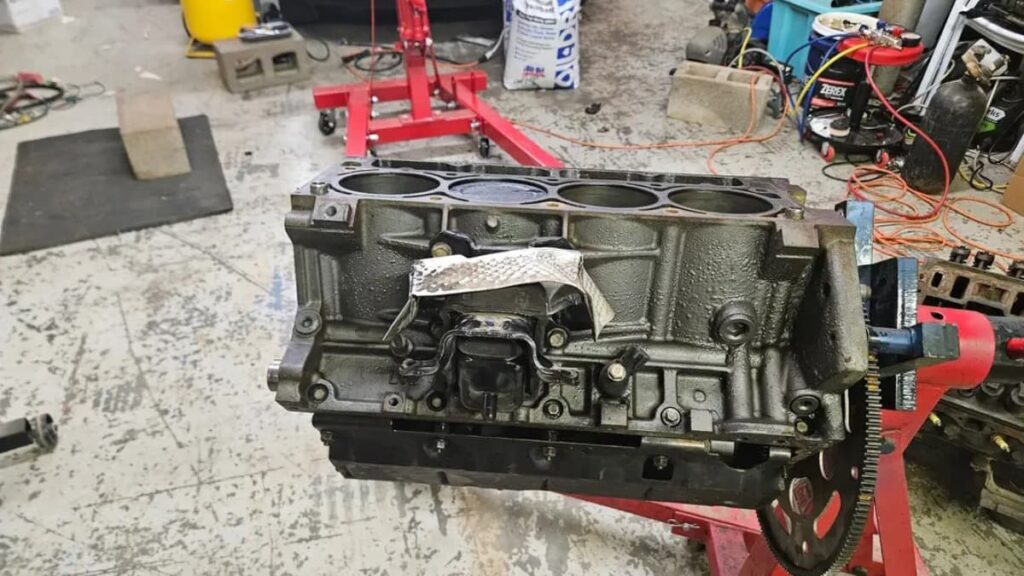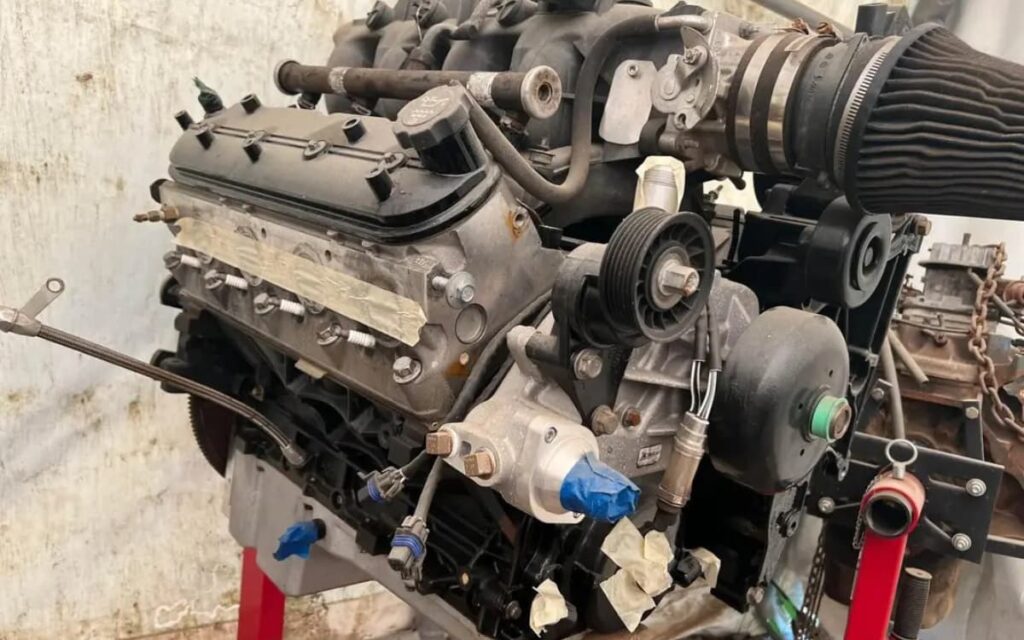A vehicle’s engine has a significant impact on its performance. Since there’s a vast automotive engine market, finding a suitable engine for your truck or SUV can be challenging. If you’re a fan of General Motors, you may consider choosing the LY6 or LQ9 engine.
But how do these two engines compare, and why should you choose them? While the LY6 and LQ9 have similarities, they differ in compression ratio, displacement, power, and torque.
This LY6 vs LQ9 detailed comparison discusses the two engines from GM. We’ll also look at their specs to help you make an informed decision.
Answer: LY6 Engine
Let’s start our LQ9 vs LY6 comparison by examining the Ly6 engine. General Motors trucks and SUVs from 2007 to 2010 used the LY6 engine. It’s a Generation 4 small-block V8 engine with 6.0L displacement. For marketing purposes, this engine was also called the Vortec 6000.
The LY6 engine replaced the LQ4 engine used in trucks and SUVs. The engine is powerful, thanks to more horsepower and torque output than its predecessor. Its cast iron block, optimized intake manifold, and aluminum cylinder heads make it a high-performance and durable engine.
GM used this engine in trucks and SUVs like the Chevrolet Silverado, Chevrolet Suburban, Chevrolet Express, GMC Savana, and GMC Sierra. Thanks to aftermarket tuning, the LY6 engine has been used in other models targeting a higher torque output.

Answer: LQ9 Engine
GM trucks and SUVs made from 2002 to 2007 used the LQ9 engine. General Motors marketed this engine as VortecMAX or Vortec HO 6000. It was a higher-performance version of the LQ4, specially designed to offer improved power and torque.
The LQ9 is a generation 3 small-block V8 engine with 6.0L displacement. It’s made of a durable iron-cast body and features aluminum cylinder heads. LQ9 has a high compression ratio, making it a high-performance engine.
GM used this engine in Cadillac but later used it in several other trucks and SUVs. Models using this engine include Cadillac Escalade, Chevrolet Silverado, and GMC Sierra.

LY6 vs LQ9: Comparison Table
This table shows the differences and similarities between the LY6 and LQ9.
| Engine Spec | LY6 | LQ9 |
| Engine Family | Generation 4 small-block V8 | Generation 3 small-block V8 |
| Horsepower | 364 HP | 345 HP |
| Torque | 383 lb-ft | 380 lb-ft |
| Compression Ratio | 9:6:1 | 10:1 |
| Displacement | 6.0L | 6.0L |
| Material | Iron-cast body with aluminum cylinder heads | Iron-cast body with aluminum cylinder heads |
| Intake Manifold | Made for rectangular-port cylinder heads | Made for cathedral-port cylinder heads |
| Fuel Delivery | Upgraded fuel delivery system | Standard fuel delivery system |
| Piston Style | Dished design (with valve reliefs) | Flat top |
Differences
Let’s examine how these engines differ.
Compression Ratio
The compression ratio is a notable difference between the LY6 and LQ9 engines. The LY6 engine has a higher compression ratio of 9:6:1, while the LQ9 has a slightly lower CR of 10:1.
An engine’s compression ratio greatly impacts its performance and efficiency.
As a result, the LY6’s high compression ratio makes it a more powerful engine than the LQ9. The engine allows a more efficient combustion process, giving it more horsepower and torque.
Engine Power and Torque
Both engines offer outstanding horsepower and torque for heavy-duty applications. They can perform excellently in various tasks such as hauling, towing, and spirited driving.
However, these engines have slight differences regarding power and torque. The LY6 engine produces 364 horsepower and 383 lb.ft of torque. On the other hand, the LQ9 delivers 345 horsepower and 380 lb.ft of torque. That makes the LY6 engine more powerful than the LQ9.
Factors such as a higher compression ratio and a more optimized intake manifold allow the LY6 engine to deliver a higher power and torque output. This engine can be an excellent choice for individuals interested in higher-performance trucks and SUVs.
Cylinder Heads
The LY6 and LQ9 engines vary when it comes to cylinder heads. And it’s worth noting that the engine’s cylinder head design determines its performance and efficiency.
The LY6 engine uses rectangular-port cylinder heads that allow improved airflow. With this design, the engine receives adequate air for combustion. The exhaust valves are also larger to ensure efficient evacuation of exhaust gasses.
Conversely, the LQ9 features cathedral-port cylinder heads. These cylinder heads are less efficient than rectangular-port ones in LY6 engines. However, cathedral-port cylinder heads provide a better balance between the engine’s horsepower and torque. This design is also more versatile and applicable in vehicles in various driving conditions.
Fuel Delivery System
While both engines feature electronic fuel injectors, the LY6 has an upgraded fuel pump and injectors. The higher-flowing fuel delivery system allows the engine to maintain a consistent fuel supply. As a result, the LY6 engine performs better, especially when under heavy loads.
Contrastingly, the LQ9 uses a standard fuel delivery system. The engine’s fuel delivery system impacts its power output and torque. But despite featuring a traditional fuel delivery system, the LQ9 ensures the combustion chamber receives adequate fuel to keep the engine running.
Intake Manifold
The engine’s intake manifold determines how much air gets to the cylinders. The engine will deliver more power and torque when the cylinders receive more airflow.
Our LY6 vs LQ9 intake manifold comparison proves that the LY6 engine allows increased airflow into the cylinders. GM designs this engine’s intake manifold to work with rectangular-port cylinder heads. Its intake runners are wider to allow more airflow and increased torque.
The LQ9 engine has an intake manifold designed for its cathedral-port cylinder heads. It features narrower runners than the LY6. However, the LQ9’s intake manifold allows adequate airflow to enhance power and torque.
Piston Style
The piston style or shape affects the engine’s compression ratio and performance. A dish-designed piston with valve reliefs ensures a higher compression ratio in the LY6 engine. This piston allows better air and fuel interaction in the combustion chamber. As a result, this engine produces more power and torque.
In contrast, the LQ9 features a flat-top piston. It provides less air and fuel interaction compared to the LY6. This engine offers lower horsepower and torque than the LY6.
Similarities
Both engines have a similar 6.0L displacement or 6000 CCs. Displacement determines the engine’s horsepower and torque. It also influences the amount of fuel the engine consumes. That’s why both engines have slight differences in horsepower and torque production.
Another similarity between the LQ9 and LY6 engines is in the material used. Both engines have iron-cast bodies and feature aluminum cylinder heads. The iron-cast engine’s body is durable even in heavy-duty applications.
Question: Is the LY6 Engine Worth the Money?
The LY6 engine is a powerful and durable engine for heavy-duty vehicles. Improved horsepower and torque allow you to easily haul, tow, or drive your auto in challenging environments. Moreover, this engine features an upgraded fuel delivery system to ensure efficient combustion and increased power output.
The LY6 engine is also compatible with many transmission units. With proper auto-tuning, you can use this engine in several car models. Furthermore, the engine’s parts are readily available.
Question: Is the LQ9 Engine Worth the Money?
The LQ9 is a high-performance, versatile, and durable engine. Its power output and versatility suit many SUVs, trucks, and vans.
This engine’s standard fuel delivery system ensures optimum combustion and better fuel economy. And thanks to the LQ9’s popularity, its spare parts are readily available.
Verdict
Hopefully, our LY6 vs LQ9 comparison allows you to choose an engine that suits your needs. Both engines have impressive power output and torque. However, the LY6 engine is popular for its higher horsepower and torque.
If you prefer a better balance between high-rpm horsepower and low-end torque, the LQ9 can be a suitable option. Despite delivering lower horsepower and torque, this engine is compatible with most heavy-duty vehicles.